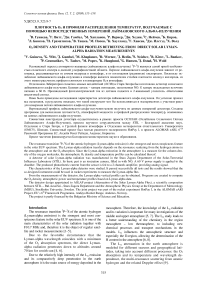02 density and temperature profiles retrieving from direct solar Lyman-alpha radiation measurements
Автор: Guineva V., Witt G., Gumbel J., Khaplanov M., Werner R., Hedin J., Neichev S., Kirov B., Bankov L., Gramatikov P., Tashev V., Popov M., Hauglund K., Hansen G., Ilstad J., Wold H.
Журнал: Солнечно-земная физика @solnechno-zemnaya-fizika
Статья в выпуске: 12 т.2, 2008 года.
Бесплатный доступ
The resonance transition 2P-2S of the atomic hydrogen (Lyman-alpha emission) is the strongest and most conspicuous feature in the solar EUV spectrum. The Lyman-alpha radiation transfer depends on the resonance scattering from the hydrogen atoms in the atmosphere and on the 02 absorption. Since the Lyman-alpha extinction in the atmosphere is a measure for the column density of the oxygen molecules, the atmospheric 02 density and temperature profiles can be calculated thereof. A detector of solar Lyman-alpha radiation was manufactured in the Stara Zagora Department of the Solar-Terrestrial Influences Laboratory (STIL). Its basic part is an ionization camera, filled in with NO. A 60 V power supply is applied to the chamber. The produced photoelectric current from the sensor is fed to a 2 channels amplifier, providing analog signal. The characteristics of the Lyman-alpha detector were studied. It passed successfully all tests and the results showed that the so-designed instrument could be used in rocket experiments to measure the Lyman-alpha flux. From the measurements of the detector, the Lyman-alpha vertical profile can be obtained. Programs are created to compute the 02 density, atmospheric power and temperature profiles based on Lyman-alpha data. The detector design appertained to ASLAF project (Attenuation of the Solar Lyman-Alpha Flux), a scientific cooperation between STIL - Bul.Acad.Sci., Stara Zagora Department and the Atmospheric Physics Group at the Department of Meteorology (MISU), Stockholm University, Sweden. The joint project was part of the rocket experiment HotPay I, in the ALOMAR eARI Project, EU's 6th Framework Programme, And0ya Rocket Range, Andenes, Norway. The project is partly financed by the Bulgarian Ministry of Science and Education.
Короткий адрес: https://sciup.org/142103276
IDR: 142103276


